The Best Tents for Every Outdoor Adventure, Tested and Reviewed
Dotdash Meredith and Yahoo Inc. may earn commission or revenue on some items through the links below.
We have top picks for backpacking, car camping, and sticking to a budget.
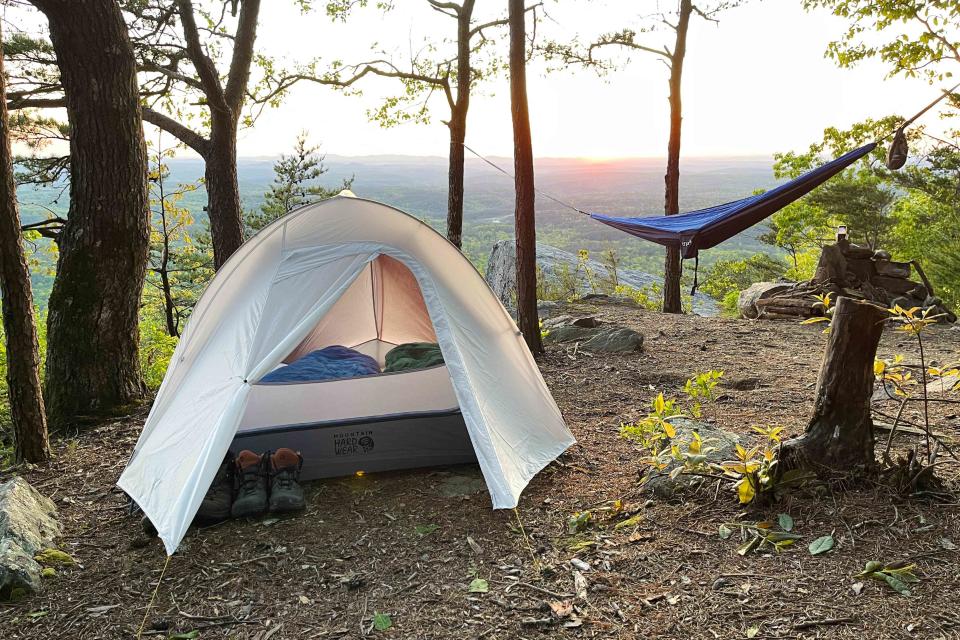
Travel + Leisure / John Somerall
From multi-day forays into the deep backcountry to occupying a drive-up spot at a local park for the weekend, we love camping. It’s the best way to immerse yourself in nature, unplug, view the stars, and relax. And the key factor in a successful camping outing is having the right tent, one that keeps you dry if it rains, breathes well and doesn’t cause internal condensation, pitches easily, and is easy to transport.
We put 18 tents to the test, using real-world conditions to access every aspect of each product, from the ease of assembly to overall performance in variable weather conditions (even dousing the tent with a garden hose when it didn’t rain to evaluate its waterproofness) and key design features that make camping easier and more enjoyable. We also talked to Bill Gamber, Founder and President Big Agnes – one of the most innovative tent makers working today, about the evolution of tent construction as well as key considerations and tips on what to look for when buying a tent.
Some tents hit the sweet spot in terms of performance and versatility. Others honed in on key features specific to different types of camping, from ultralight tents built for the most discerning backpacker to cavernous car-camping tents big enough for your entire brood.
Best Overall: Nemo Aurora Highrise 4 Person Camping Tent
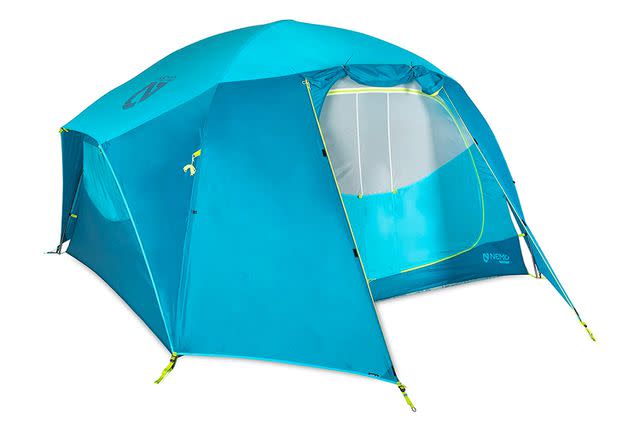
Why We Love It
Easy to assemble, durable enough for most weather conditions, and sporting ample internal storage, the Aurora Highrise is the perfect outdoor home for tall, gear-loving campers.
What to Consider
The rainfly doesn’t come all the way to the ground on all sides, a potential drawback for winter camping.
With a max peak height of 72 inches and near-vertical walls that really open up the interior space, the Aurora Highrise from Nemo won us over thanks to the ease-of-assembly, detailed internal gear storage, and its ample headroom for tall campers. Despite its noticeable height, it stood up to heavy winds while camping on the beach even though the guy lines weren’t tied down. The durable fabric worked to block out the elements, and the aluminum poles perfectly balance the weight-to-strength ratio you’d expect in a high-end tent. Large side windows worked well to help regulate air circulation, and the two doors open onto generous vestibules.
Nemo really packed in all the small details destined to woo you, including the brand’s Gatekeeper door clips, a pocket that transforms your headlamp into a tent lantern, and multiple gear pockets. And disassembly happened even faster than pitching the tent, taking about five minutes – the whole package can be easily stored in the included duffle storage sack for quick transport from car to campsite. The light blue color makes this tent stand out, and the internal 150D PU poly tent floor comes in a bold pattern, a design element that’s supposed to add a bit of whimsy and fun … but that some campers may not like.
Price at time of publish: $500
The Details: 13.8 pounds | 90 x 100 x 75 inches | 4 people
Best Budget: Coleman Sundome Tent

Why We Love It
The Sundome Tent is incredibly spacious in terms of internal square footage and height, and it’s perfect for a basic night of camping for a large crew of campers.
What to Consider
The side gear pockets could be a bit larger, and there are no vestibules.
Coleman stitched the pitching instructions onto the carrying bag of the Sundome Tent, but it was so easy to assemble, we didn't need it – the tent went up in five minutes, and assembling it solo was no problem. With a tent floor that spans 10 x 10 feet, the interior space is massive – enough space to accommodate two queen-sized airbeds, and a center height of 6 feet means most campers don’t have to bend over while entering or standing inside. Awnings at the front door and rear window provide added weather protection, which works with the brand’s WeatherTec system – a tub-like floor with welded corners, inverted seams, and taped seams on the rainfly and tent body to block out water — while the strong frame has been tested to withstand 35-mile-per-hour winds. In addition to two windows, the tent also has a ground vent that works well to allow cool air to circulate and push out the hot air. And when the tent was disassembled, everything fit neatly into the storage bag, a detail that we appreciated given the typical frustrations of trying to make all parts fit into most stuff sacks.
Price at time of publish: $99
The Details: 18 pounds | 10 x 10 x 6 feet | 6 people
Easiest Setup: REI Co-op Half Dome SL 2+ Tent With Footprint
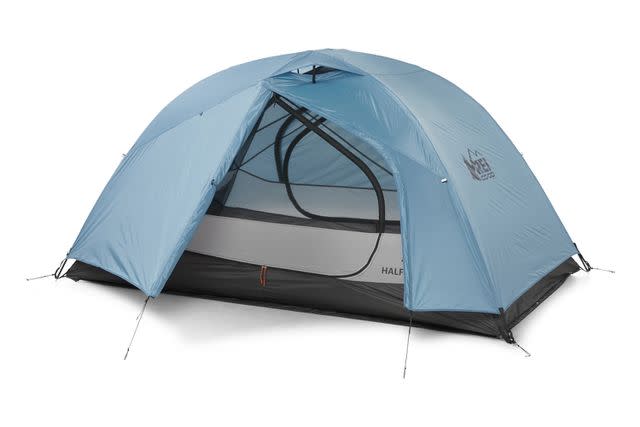
Why We Love It
The hub pole design of the Half Dome SL 2+ makes assembly intuitive and fast, and the interior provides enough space for two campers and loads of gear.
What to Consider
As it’s meant for backpacking, the internal space may feel constrictive to some campers longing for more space or a taller ceiling.
Rather than making you fuss with tent sleeves during assembly, the REI Co-op Half Dome SL 2+ employs a hubbed pole system – simply unfurl the tent, assemble the poles, and then clip the poles onto the frame and you’re done. The free-standing backpacking tent provides enough space for two people plus extra room for lots of gear (or your camping dog), with a peak height of 42 inches. Two-sided entry (each with vestibules) made it easy for us to exit and store extra gear, and mesh panels in the upper portion of the tent improve ventilation – and views – while the fly design lets you roll up the sides and allow more airflow. There’s also two closable ceiling vents to avoid condensation build-up.
Price at time of publish: $231
The Details: 4.7 pounds | 90 x 54 x 42 inches | 2+ person
Related: The 9 Best Camping Air Mattresses of 2023, Tested and Reviewed
Best for Backpacking: Nemo Dagger Osmo 2P Tent
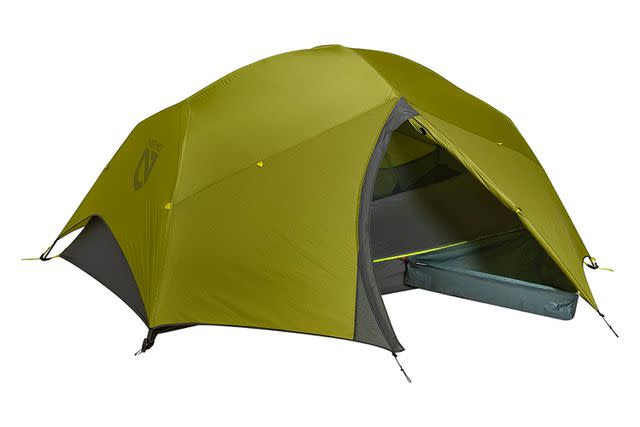
Why We Love It
Low in weight and high in internal space, the Dagger Osmo makes for the perfect two-person backpacking tent with loads of camp-friendly extras and durable construction that’s meant to last.
What to Consider
The price is a bit higher compared to other tents on our list, but the overall quality of the product means it’ll last a long time.
With a feathery 3.3 pound minimal weight, the Nemo Dagger Osmo 2-person Tent will appease even the most arduous backpacker. A 31.3-square-foot interior and a peak height of 42 inches provide ample space for two campers and their gear, with additional storage options in the vestibules. The pitching instructions weren’t included, but thankfully the tent parts are color-coded, which helped us align the poles to the proper clips, and since all the poles are integrated into one system, the frame went up quickly. Built with a proprietary blend of poly and nylon, the tent boasts impressive water repellency, minimal stretch when wet, and a higher strength rating compared to similar fabrics, details that kept things dry when we were caught in a prolonged, heavy rainstorm. In addition to the extra space and weather protection, Nemo packs in the small details, including a Landing Zone (a triangular piece of fabric that hooks to the outside of the tent for your shoes), an easy-to-use stuff sack that’s designed to let you split up the tent between two backpackers, one-handed door clips, and Nightlight Pockets, which transform your headlamp into a mellow, even tent lantern.
Price at time of publish: $530
The Details: 4.1 pounds | 90 x 50 x 42 inches | 2-person
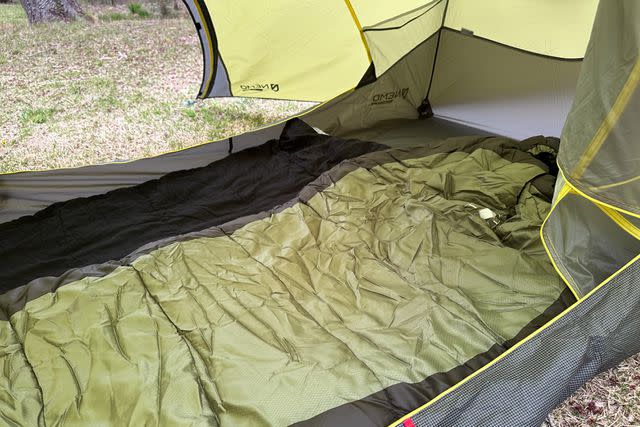
Travel + Leisure / Taylor Fox
Best Budget Backpacking: REI Co-op Trailmade 2 Tent With Footprint
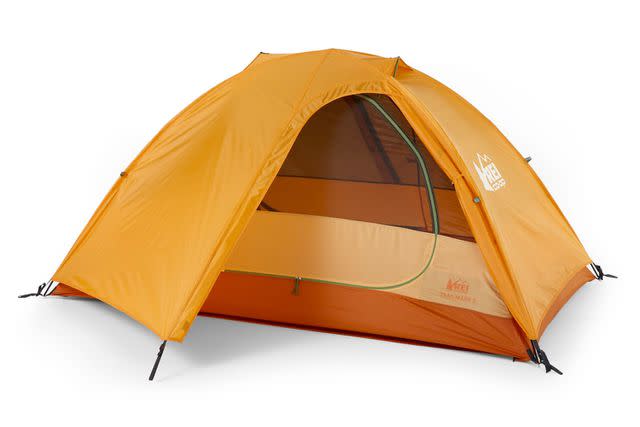
Why We Love It
With an approachable price point, the REI Trail Made Tent is a great way to introduce yourself to backpacking, offering enough space for two hikers along with wide vestibules to protect your gear.
What to Consider
The vents add a bit of air circulation, but more venting would be nice.
Nothing makes for a more frustrating – and exhausting – experience than struggling to pitch your tent after a long day of backpacking, which is why we appreciated the ease of which the REI Trail Made 2-person Tent went up quickly. It uses hooks to secure the poles (rather than fabric sleeves), and we didn’t even have to refer to the instructions attached to the stuff sack. As you’d expect from a backpacking-focused tent, the 88 x 52-inch floor area provides enough space for two adults but little else, and a peak height of 39.9 inches allows for easy kneeling but not standing. But ample vestibules on both sides, along with two wide doors, make it effortless to keep your gear dry. Weighing in with a minimal packing weight of 4.4 pounds, it’s light enough to carry for days, and the packed dimensions of 8.5 x 22 inches means it won’t swallow up loads of space in your pack. The stuff sack also has a bit of extra space to accommodate a small tarp. The rainfly employs straps that buckle into place, so you can loosen them for more ventilation or tighten everything down when the weather turns foul. Gear-heads will also love the internal organization, which includes pockets and gear loops – and, unlike most tents, it also comes with a footprint, which will help extend the life of this already-durable tent.
Price at time of publish: $179
The Details: 5.4 pounds | 88 x 52 x 39.9 inches | 2 people
Best Weather Resistance: Hilleberg Allak 2 Tent
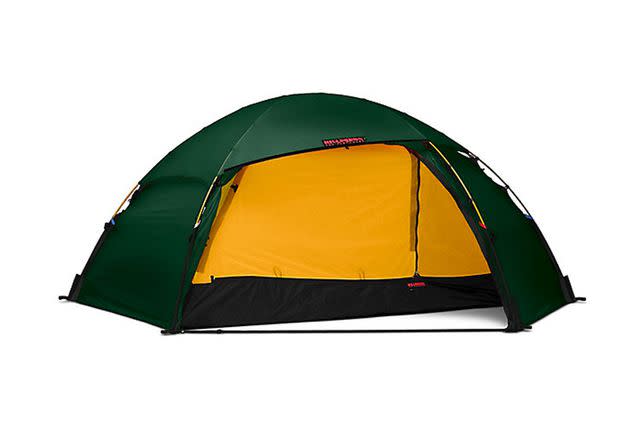
Why We Love It
With bomber materials, several options to control airflow, and the ability to be pitched securely anywhere, the Allak 2 will stand up to the worst of Mother Nature, season after season.
What to Consider
This is a tent for serious campers, backpackers, and boat or bike touring and is likely too much for a casual camper.
Foul weather can be an unavoidable consequence of heading outdoors, but if you like to camp year-round in any kind of condition, go with the Hilleberg Allak 2. This backpack-friendly two-person tent is constructed of durable, weather-resistant Kerlon 1200 on the outer that’s been triple-coated with silicone, along with a DWR ripstop nylon inner layer and a 70D tripe-coated poly floor, and it uses a three 9-millimeter pole frame that stood up to harsh winds during our testing. The freestanding tent can be pitched anywhere, with guy lines and stakes to help security, while the outer walls extend to the ground and include mesh areas backed with adjustable fabric panels to customize the air circulation for various conditions. With lots of car camping and backpacking experience under our belts, we found that the 31.2-square-foot interior felt roomier than other two-person backpacking tents, while the domed architecture allowed for ample headroom – though the 41-inch max height means you probably can’t stand. In addition to the lower mesh vents, the roof has an adjustable vent that circulated air almost like a ceiling fan, which really improved circulation to provide comfort and combat condensation. Overall, we were particularly taken by the quality of materials and craftsmanship, with each Hilleberg tent being hand-made and inspected to deliver the best product possible.
Price at time of publish: $1,165
The Details: 7.2 pounds | 88 x 51 x 41 inches | 2 people
Related: The Best Camping Chairs of 2023, Tested by Outdoor Experts
Best Ultralight: Mountain Hardwear Nimbus UL 2 Tent
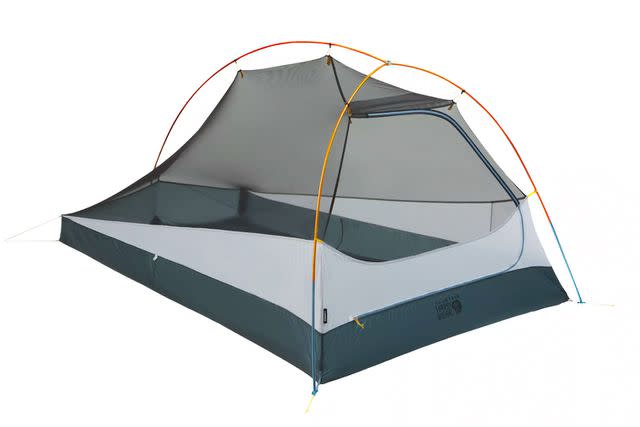
Why We Love It
Though it’s one of the lightest backpacking tents on the market, the Nimbus UL 2 doesn’t skimp on the essentials, including ample ventilation, weather protection, a good-sized interior, and very quick setup.
What to Consider
The single door helps cut down on excess weight, but it means two campers have to use the same entrance, and it’s important to stake down the tent as you pitch it because it’s light enough to get blown by a strong wind if it isn’t weighed down.
Ounce-counters rejoice! The Nimbus UL 2 Tent from Mountain Hardwear weighs in at an astonishingly low 2 pounds (trail weight) – without sacrificing the key features you want in a backpacking tent, including 28.1 square feet of internal space, an additional 7.7 square feet of storage in the vestibule, and minimal pack size of only 6 x 12 inches. During our testing, the tent held up to variable conditions, including foul weather and wind gusts of up to 40 miles per hour, with the pointed rear of the tent positioned to distribute the force of the wind. We love that the tent comes with a three-quarter mesh canopy that allows for ample circulation and star gazing when the weather cooperates, and the sil-nylon rainfly goes on quickly and is 100 percent waterproof. Ventilation also proved to be plentiful, even with the fly on, and no condensation appeared after a particularly humid night. Setup and breakdown were a breeze, clocking in at around three minutes.
Price at time of publish: $315
The Details: 2.28 pounds | 86 x 42 x 41 inches | 2 person
Best 6-person: Marmot Limestone 6-person Tent
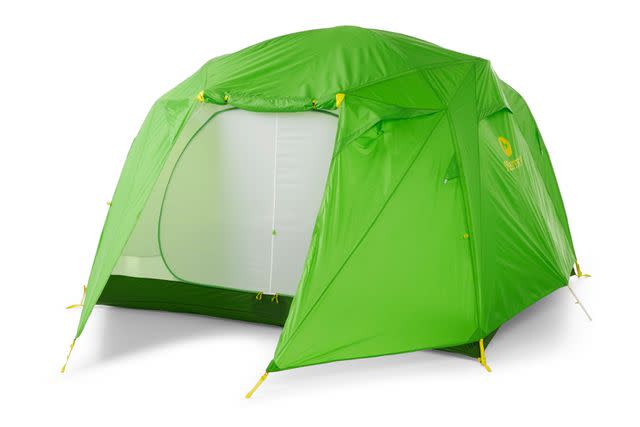
Why We Love It
The Limestone 6P Tent is huge, providing ample space for a number of campers and their corresponding gear, and setup was quick and painless.
What to Consider
It takes a bit of practice to successfully fold the tent so that it fits in the carrying case.
The Marmot Limestone 6P Tent is downright cavernous, with a 89.9-square-foot floor area, an additional 40 square feet of protective storage in the vestibule, and a peak height of 76 inches, enough space for us to stand without issue. Yet, despite its massive size, it was easy to set up thanks to the color-coded poles, clips, and fly, taking one person about 15 minutes. The waterproof fly comes with taped seams for full coverage, with plenty of venting to avoid overheating or condensation – a key feature for a multi-person tent – though it could benefit from a bit more air circulation. When weather isn’t an issue, the mesh ceiling affords star gazing, and Marmot also adds all the right mini-features, like internal pockets for gear storage and a lampshade pocket to hold your headlamp and provide ambient light.
Price at time of publish: $370
The Details: 17 pounds | 120 x 100 x 76 inches | 6 person
Other Tents We Liked
The North Face Wawona 6: The Wawona won high marks for its high-quality materials and ample weather protection, but the instructions weren’t very clear and it took a while — and at least two people — to pitch the tent for the first time, and though the tent is rated to fit six, four campers seemed more realistic.
REI Co-op Wonderland 6 Tent at REI: This turned out to to be plenty roomy, having space for a queen-sized air mattress, a twin cot, and a dog bed with room to spare, but the massive tent is hard to pitch solo and can take up to 30 minutes to assemble, a major drawback if you’re trying to set the tent up while it’s raining. The price was also a bit high, and it didn’t come with a footprint or vestibule, though the wide awning at the door offers some protection.
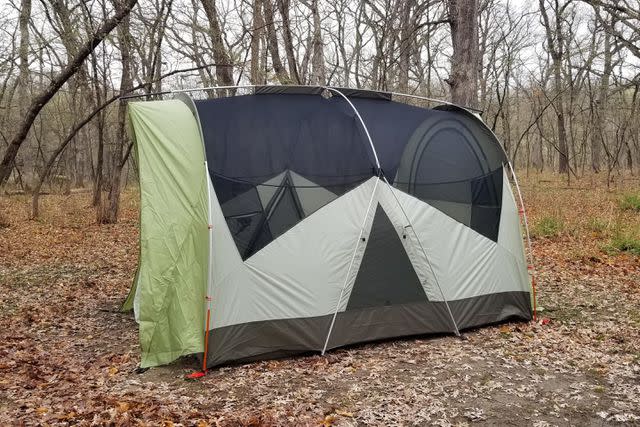
Travel + Leisure / Megan Wood
Our Testing Process
We tested 18 tents in real-world environments, everywhere from a palatial backyard to deep into the wilderness of a national park to assess how well each product performed in a variety of different temperatures and weather conditions. Each tent was then evaluated on the key features – the ease of setup and takedown, the overall design, durability, weatherproofness, portability, ease of use, internal air circulation, and overall value, which weighed the key features against its price point. Then, every tent was evaluated on a one-to-five scale on each of those key elements to narrow the selections to the ones included in this round-up.
To broaden the appeal of the tent offerings, our testers ranged from casual car campers to diehard backpackers who love to clock in serious miles in the backcountry so that there would be a preferred selection regardless of your skill level or desire to execute certain types of outings. In addition to confirming that each tent delivered the essentials - ease of assembly and portability, serious waterproof protection, and ample internal space for the desired number of campers - we also took note of the little features, like gear pockets or those that are designed for your headlamp to be transformed into a camp lantern, which helped narrow our suggestions even further. The testing will continue over the next six months to see how well the tents perform over time during rigorous use.
Tips for Buying a Tent
Understand waterproofing levels
Any tent worthy of its name will provide waterproof protection, typically by employing a rainfly that sits over the actual tent, which usually comes with a mesh ceiling to aid in air circulation and to allow you to soak in the views. But higher-quality tents utilize DWR and the latest waterproof fabrics to really seal out the elements. Just be sure that the fly goes all the way to the ground when it’s pitched, and ensure that you have guy lines and tie-off points that let you remove any slack in the fly, which can cause water to pool. Your tent should also be able to stand up to heavy winds. The better brands use wind tunnels to validate the tent’s stability.
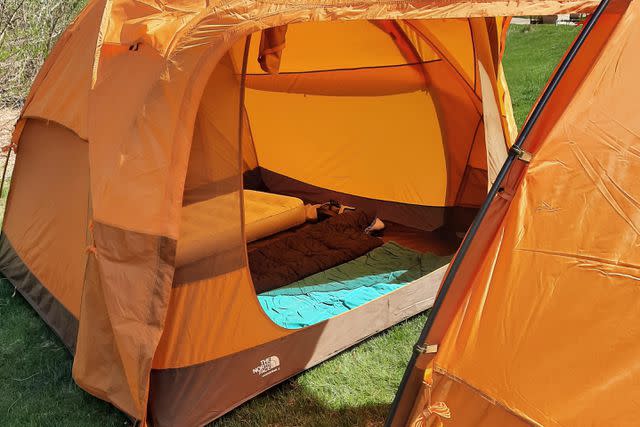
Travel + Leisure/Ben Anderson
Choose ventilation wisely
Whether it's from humid and hot conditions or from the natural heat your body generates, the inside of a tent can get warm quickly, leading to uncomfortable sleep and the build-up of condensation, especially when the rainfly is on and the doors are closed. To combat this, tent designs employ venting within the fly itself so that you can allow a bit of airflow, as well as mesh panels at the base of the tent to improve circulation. If it’s not raining, there are also a few other things you can do. Be sure to pitch the tent so that the door faces the breeze (if there is any) and stake out the fly and provide ample tension so that it maximizes the airspace between the fly and the walls of the tent. Also look for tents that have mesh windows and ones that let you roll up and secure the doors on the rainfly to maximize circulation.
Remember ease of setup
In the best of worlds, you’ll have clear skies and ample help to pitch your tent. But the realities of the wild mean that the faster the tent can be set up, the sooner you’re dry. For all but the biggest tents, setup shouldn’t take more than ten minutes, tops. Tent manufacturers typically use a color-coded system to let you know which poles align with which clips and/or sleeves and also offer visual instructions (that are typically printed on the carry case so you never lose them). The quickest-to-pitch tents typically employ clips to attach the poles rather than fabric sleeves, and some have attached all the poles to one system, which makes pitching the tent faster and less confusing.
Frequently Asked Questions
How big of a tent do I need?
Car campers can benefit from bigger tents with more space without having to worry about the tent’s weight, while backpackers should find the sweet spot between size and weight – sometimes lugging a 4-pound tent is worth the trade-off to have extra internal space. The size of the vestibules – the space that’s at the door (or doors) created when the rainfly is assembled and staked out – should also be taken into account as it affords storage space for gear, keeping things dry while freeing up the internal space of the tent. For the most comfortable long-term camping experience, we recommend getting a tent with a listed capacity of two more people than you anticipate will be using it.
How much should I spend on a tent?
Prices vary greatly based on the type of tent, the size, and the key purposes (car camping versus backpacking, solo camping versus family camping, etc). Bill Gamber advises that the price of a tent aligns roughly with the quality of the materials used as well as extra features. You can find lower-cost tents around $100, but they’ll be made of heavy materials that aren’t built to last and likely employ environmentally unfriendly manufacturing processes. So it’s smart to invest in a higher-quality tent, and that goes double for backpacking tents, which provide your only refuge when you’re out in the wild. You also benefit from lighter, more durable materials, smaller pack size, smart features like internal storage and hooks that hold your headlamp and double as a tent lantern, and ample vestibule space to store your gear.
What is a tent footprint?
A footprint is an additional piece of protective fabric that’s designed to lay under the floor of your tent, which adds another layer of moisture protection and also protects the tent itself from abrasive elements like rocks or roots, which in turn extends the life of your tent. Some tents come with footprints, and almost all tent-makers sell footprints for their tents, which exactly match the dimensions of your tent floor and will work with the poles and clips once the tent is pitched. But you can also get much of the same protection by using a standard tarp, provided it covers the floor of the tent.
How do I make tents warm and comfortable?
In addition to using a high-quality, warm sleeping bag, wearing a hat, and other cold-weather hacks like sleeping with a water bottle with hot water, the tent itself can add 5 to 10 degrees of warmth. On cold nights, be sure all the doors are closed and that the rainfly extends to the ground to avoid any air circulating from underneath. On really cold nights, you can also close the vents (typically secured via velcro) to block cold air from circulating, but in more temperate conditions, a little bit of venting helps fight off internal condensation as the temperature of your tent responds to your body heat.
How do I clean a tent?
Gamber advises, first and foremost, to never store your tent when it’s damp or in damp weather. “The tents can really hold moisture and then that just kills the waterproofness, the polyurethane coating or silicone. It can also cause mold,” he says. Always be sure your tent is 100 percent dry before putting it into storage, and keep it in a room with low humidity. In terms of spot-cleaning stains or dirt, you can use a standard detergent to get rid of any marks. And also be sure the tent doesn’t have any branches or rocks inside, which could potentially tear the tent fabric or rainfly.
Why Trust Travel + Leisure
Nathan Borchelt has been rating, reviewing, and writing about outdoor and travel gear for decades, and is a life-long camper, with countless outings both backpacking and car camping throughout the world. In addition to his insight, he worked with a cadre of testers who put each tent through real-world tests to evaluate the key features, ease of set-up and take-down, overall durability and weather protections, key design features, and price–rating each key feature on a one-to-five scale. Then we layered in additional research and feedback from camping experts to narrow and refine the final list of recommendations.
Related: The 8 Best Camping Cots of 2023, Tested and Reviewed
Love a great deal? Sign up for our T+L Recommends newsletter and we'll send you our favorite travel products each week.
For more Travel & Leisure news, make sure to sign up for our newsletter!
Read the original article on Travel & Leisure.

